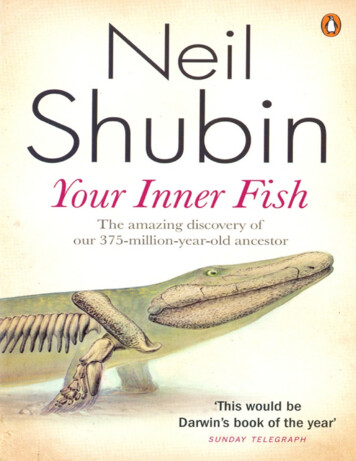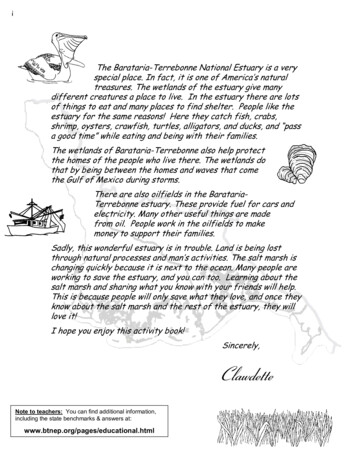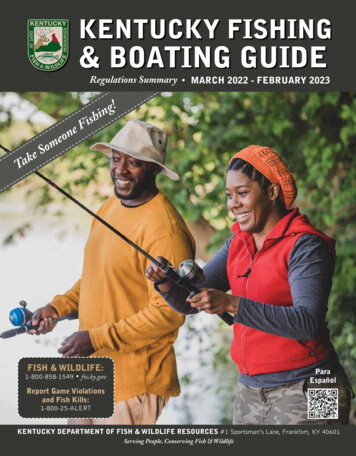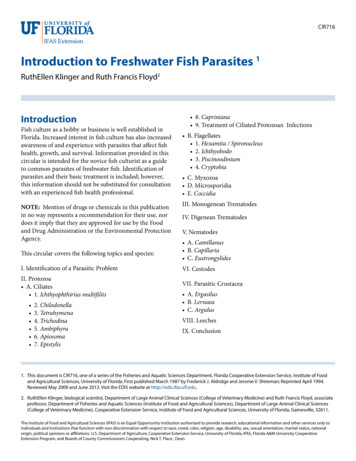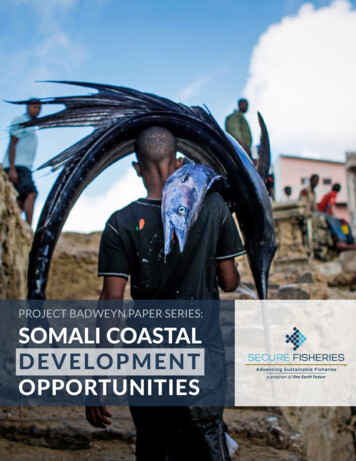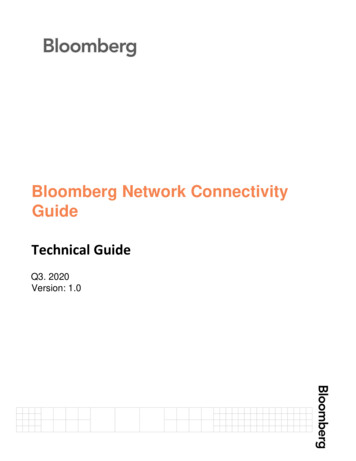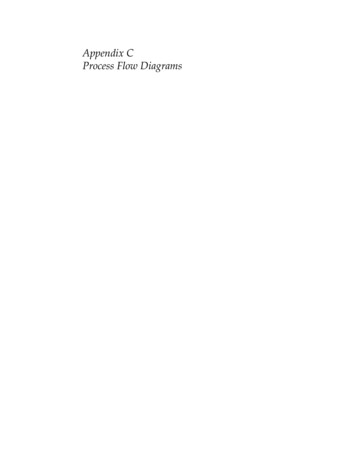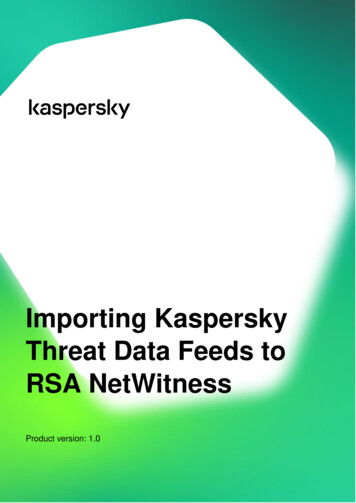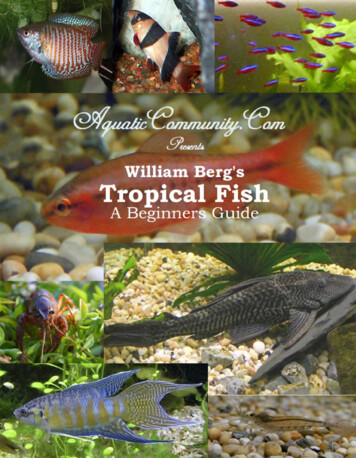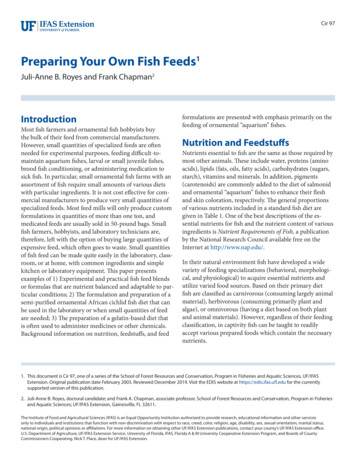
Transcription
Cir 97Preparing Your Own Fish Feeds1Juli-Anne B. Royes and Frank Chapman2IntroductionMost fish farmers and ornamental fish hobbyists buythe bulk of their feed from commercial manufacturers.However, small quantities of specialized feeds are oftenneeded for experimental purposes, feeding difficult-tomaintain aquarium fishes, larval or small juvenile fishes,brood fish conditioning, or administering medication tosick fish. In particular, small ornamental fish farms with anassortment of fish require small amounts of various dietswith particular ingredients. It is not cost effective for commercial manufacturers to produce very small quantities ofspecialized feeds. Most feed mills will only produce customformulations in quantities of more than one ton, andmedicated feeds are usually sold in 50-pound bags. Smallfish farmers, hobbyists, and laboratory technicians are,therefore, left with the option of buying large quantities ofexpensive feed, which often goes to waste. Small quantitiesof fish feed can be made quite easily in the laboratory, classroom, or at home, with common ingredients and simplekitchen or laboratory equipment. This paper presentsexamples of 1) Experimental and practical fish feed blendsor formulas that are nutrient balanced and adaptable to particular conditions; 2) The formulation and preparation of asemi-purified ornamental African cichlid fish diet that canbe used in the laboratory or when small quantities of feedare needed; 3) The preparation of a gelatin-based diet thatis often used to administer medicines or other chemicals.Background information on nutrition, feedstuffs, and feedformulations are presented with emphasis primarily on thefeeding of ornamental “aquarium” fishes.Nutrition and FeedstuffsNutrients essential to fish are the same as those required bymost other animals. These include water, proteins (aminoacids), lipids (fats, oils, fatty acids), carbohydrates (sugars,starch), vitamins and minerals. In addition, pigments(carotenoids) are commonly added to the diet of salmonidand ornamental “aquarium” fishes to enhance their fleshand skin coloration, respectively. The general proportionsof various nutrients included in a standard fish diet aregiven in Table 1. One of the best descriptions of the essential nutrients for fish and the nutrient content of variousingredients is Nutrient Requirements of Fish, a publicationby the National Research Council available free on theInternet at http://www.nap.edu/.In their natural environment fish have developed a widevariety of feeding specializations (behavioral, morphological, and physiological) to acquire essential nutrients andutilize varied food sources. Based on their primary dietfish are classified as carnivorous (consuming largely animalmaterial), herbivorous (consuming primarily plant andalgae), or omnivorous (having a diet based on both plantand animal materials). However, regardless of their feedingclassification, in captivity fish can be taught to readilyaccept various prepared foods which contain the necessarynutrients.1. This document is Cir 97, one of a series of the School of Forest Resources and Conservation, Program in Fisheries and Aquatic Sciences, UF/IFASExtension. Original publication date February 2003. Reviewed December 2019. Visit the EDIS website at https://edis.ifas.ufl.edu for the currentlysupported version of this publication.2. Juli-Anne B. Royes, doctoral candidate; and Frank A. Chapman, associate professor, School of Forest Resources and Conservation, Program in Fisheriesand Aquatic Sciences; UF/IFAS Extension, Gainesville, FL 32611.The Institute of Food and Agricultural Sciences (IFAS) is an Equal Opportunity Institution authorized to provide research, educational information and other servicesonly to individuals and institutions that function with non-discrimination with respect to race, creed, color, religion, age, disability, sex, sexual orientation, marital status,national origin, political opinions or affiliations. For more information on obtaining other UF/IFAS Extension publications, contact your county’s UF/IFAS Extension office.U.S. Department of Agriculture, UF/IFAS Extension Service, University of Florida, IFAS, Florida A & M University Cooperative Extension Program, and Boards of CountyCommissioners Cooperating. Nick T. Place, dean for UF/IFAS Extension.
Increased understanding of the nutritional requirementsfor various fish species and technological advances in feedmanufacturing, have allowed the development and useof manufactured or artificial diets (formulated feeds) tosupplement or to replace natural feeds in the aquacultureindustry. An abundant supply of feedstuffs are available,and farmers and hobbyists are now able to prepare theirown fish feeds from locally available ingredients.Proteins and Amino Acids. Fish meal, soybean meal, fishhydrosylate, skim milk powder, legumes, and wheat glutenare excellent sources of protein. Additionally, the buildingblocks of proteins (free amino acids) such as lysine andmethionine are commercially available to supplement thediet.Utilizing raw fish as a main ingredient in fish feeds has longbeen recognized to be harmful to the health and growthof fish due primarily to the presence of the anti-nutrient,thiaminase. Thiaminase, an enzyme that destroys thiamine(vitamin B-1), one of the essential water-soluble vitamins,is mostly found in freshwater fish and is destroyed by heat(i.e., cooking). Other concerns related to using raw fish indiets include the spread of infectious diseases such as mycobacterium and botulism. In preparing diets, preferential useof marine fish is suggested to minimize thiaminase activity,and raw fish could be steamed or poached.Lipids. Oils from marine fish, such as menhaden, andvegetable oils from canola, sunflower, and linseed, arecommon sources of lipids in fish feeds.Carbohydrates. Cooked carbohydrates, from flours of corn,wheat or other “breakfast” cereals, are relatively inexpensivesources of energy that may spare protein (which is moreexpensive) from being used as an energy source.Vitamins and Minerals. The variety and amount ofvitamins and minerals are so complex that they are usuallyprepared synthetically and are available commercially as abalanced and pre-measured mixture known as a vitamin ormineral premix. This premix is added to the diet in generous amounts to ensure that adequate levels of vitamins andminerals are supplied to meet dietary requirements.Pigments. A variety of natural and synthetic pigments orcarotenoids are available to enhance coloration in the fleshof salmonid fish and the skin of freshwater and marineornamental fish. The pigments most frequently used supplythe colors red and yellow. The synthetically producedpigment, astaxanthin (obtained from companies such asCyanotech and F. Hoffmann-La Roche Ltd.), is the mostPreparing Your Own Fish Feedscommonly used additive (100–400 mg/kg). Cyanobacteria(blue-green algae such as Spirulina), dried shrimp meal,shrimp and palm oils, and extracts from marigold, redpeppers and Phaffia yeast are excellent natural sources ofpigments.Binding Agents. Another important ingredient in fishdiets is a binding agent to provide stability to the pellet andreduce leaching of nutrients into the water. Beef heart hastraditionally been used both as a source of protein and as aneffective binder in farm-made feeds. Carbohydrates (starch,cellulose, pectin) and various other polysaccharides, such asextracts or derivatives from animals (gelatin), plants (gumarabic, locust bean), and seaweeds (agar, carageenin, andother alginates) are also popular binding agents.Preservatives. Preservatives, such as antimicrobials andantioxidants, are often added to extend the shelf-life offish diets and reduce the rancidity of the fats. Vitamin Eis an effective, but expensive, antioxidant that can be usedin laboratory prepared formulations. Commonly availablecommercial antioxidants are butylated hydroxyanisole(BHA), or butylated hydroxytoluene (BHT), and ethoxyquin. BHA and BHT are added at 0.005% of dry weightof the diet or no more than 0.02% of the fat content in thediet, while ethoxyquin is added at 150 mg/kg of the diet.Sodium and potassium salts of propionic, benzoic or sorbicacids, are commonly available antimicrobials added at lessthan 0.1% in the manufacture of fish feeds.Attractants. Other common additives incorporated intofish feeds are chemoattractants and flavorings, such as fishhydrosylates and condensed fish solubles (typically addedat 5% of the diet). The amino acids glycine and alanine, andthe chemical betaine are also known to stimulate strongfeeding behavior in fish. Basically, attractants enhance feedpalatability and its intake.Other Feedstuffs. Fiber and ash (minerals) are a group ofmixed materials found in most feedstuffs. In experimentaldiets, fiber is used as a filler, and ash as a source of calciumand phosphorus. In practical diets, both should be nohigher than 8–12% of the formulation. A high fiber and ashcontent reduces the digestibility of other ingredients in thediet resulting in poor growth of the fish.Other common feedstuffs used in ornamental fish dietsinclude live, frozen, or dried algae, brine shrimp, rotifers orother zooplankton. The addition of fish or squid meal willenhance the nutritional value of the diet and increase its acceptance by the fish. Fresh leafy or cooked green vegetablesare often used. Although vegetables are composed mainly2
of water, they contain some ash, carbohydrates, and certainvitamins. Kale, dandelion greens, parsley, and turnip greensare examples of relatively nutritious vegetables.Feed FormulationsWith few exceptions, feeding a single type of food is neithercomplete nor balanced and does not supply all the nutrientsa fish might need in its diet. Hence, two or more ingredientsshould be mixed into homemade, laboratory and commercial feed formulations. A diet may be formulated to supplement natural foods already available in the productionsystem or as a complete formulation when no other foodsare provided. A complete diet must be nutritionally balanced, palatable, water stable, and have the proper size andtexture. If natural foods are not incorporated in ornamentalfish diets, the feed must be supplemented with natural orsynthetic pigments.The nutrient composition of numerous feedstuffs can befound in the literature and on the Internet. Two books thatdeal almost entirely with nutrient composition of feedstuffsare 1) Handbook on Ingredients for Aquaculture Feedsand 2) Standard Methods for the Nutrition and Feeding ofFarmed Fish and Shrimp. Another book, which is availablefree on the Internet is United States-Canadian Tables ofFeed Composition, found at http://nap.edu/. Also, availablethrough the Internet is the information provided by theUSDA Nutrient Data Laboratory at http://www.ars.usda.gov/main/site main.htm?modecode 80-40-05-25.Feeds are formulated to be dry, with a final moisturecontent of 6–10%, semi-moist with 35–40% water or wetwith 50–70% water content. Most feeds used in intensiveproduction systems or in home aquaria are commerciallyproduced as dry feeds. Dry feeds may consist of simpleloose mixtures of dry ingredients, such as “mash or meals,”to more complex compressed pellets or granules. Pelletsare often broken into smaller sizes known as crumbles. Thepellets or granules can be made by cooking with steam orby extrusion. Depending on the feeding requirements of thefish, pellets can be made to sink or float.Flakes are another form of dry food and a popular dietfor aquarium fishes. Flakes consist of a complex mixtureof ingredients, including pigments. These are made into aslurry which is cooked and rolled over drums heated bysteam.Semi-moist and wet feeds are made from single or mixedingredients, such as trash fish or cooked legumes, and canbe shaped into cakes or balls.Preparing Your Own Fish FeedsFeed PreparationThere is no single way for the preparation of formulatedfish feeds; however, most methods begin with the formationof a dough-like mixture of ingredients. Ingredients can beobtained from feed stores, grocery stores, pharmacies, andspecialty stores such as natural food stores, as well as fromvarious companies that may be found through the internet.The dough is started with blends of dry ingredients, whichare finely ground and mixed. The dough is then kneadedand water is added to produce the desired consistency forwhatever fish is going to be fed. The same dough may beused to feed several types of fish, such as eels and smallaquarium fish.Pelleting or rolling converts the dough into pellets or flakes,respectively. The amount of water, pressure, friction, andheat greatly affects pellet and flake quality. For example,excess water in the mixture results in a soft pellet. Too littlemoisture and the pellet will crumble.Proteins and especially vitamins are seriously affected byhigh temperatures. Therefore, avoid storing diet ingredientsat temperatures at or above 70 C (158 F) and do notprepare dry feeds with water at temperature higher than92 C (198 F).Tools and Storage ProceduresMaking your own fish feed requires few specialized tools.The tools are used primarily for chopping, weighing,measuring ingredients, and for blending, forming anddrying the feed.Most of the utensils needed will already be in the laboratoryor kitchen. Multipurpose kitchen shears, hand graters, aparing knife, a 5-inch serrated knife, a 6- to 8-inch narrowblade utility knife, and a 10-inch chef knife for cutting,slicing, and peeling can be used. A couple of plastic cuttingboards protect the counter and facilitate handling the rawingredients. Heat resistant rubber spatulas, wooden andslotted spoons, long-handled forks, and tongs are very goodfor handling and mixing ingredients. A basic mortar andpestle, electric blender, food processor, or coffee grinderare very useful to chop or puree ingredients; use grindersieves and mince die plates to produce the smallest particlesize possible. A food mill and strainer such as a colanderor flour sifter help discard coarse material and obtain finefood particles. For weighing and measuring ingredients,dry and liquid measuring cups and spoons, and a food orlaboratory bench scale are required. Other utensils includeplastic bowls (1½, 3, 5, and 8 quarts) for weighing and3
mixing ingredients, a thermometer, and a timer. A 3-quartsaucepan and 10-inch stockpot are good for heating gelatinsand cooking raw foods such as vegetables and starches. Theingredients and blends may be cooked in a small electric orgas burner. A few trivets to put under hot pans will protectcounters and table tops.Ingredients may be mixed by hand using a rotary beater orwire whisk; however, an electric mixer or food processor ismore efficient. After mixing, a dough is formed that can befashioned into different shapes.A pasta maker, food or meat grinder will extrude the doughinto noodles or “spaghetti” of different diameters. As thenoodles emerge from the outside surface of the die, theycan be cut off with a knife to the desired length or crumbledby hand, thus making pellets. A potato ricer also servesto extrude the dough into noodles of the same size. Formaking flakes, a traditional hand-cranked or electric pastamaker will press out the dough into thin sheets.The pellets or thin sheets can be placed on a cookie sheetand dried in a household oven on low heat or in a forcedair oven. A small food dehydrator also performs the taskquite well. To add extra oil and/or pigments to pellets, ahand-held oil atomizer or sprayer can is useful. To separatepellets into different sizes, a set of sieves (e.g., 0.5, 0.8, 1.0,2.0, and 3.0 mm) is required.One simple formulation, which is used traditionally to feedornamental fish in ponds, consists of a mixture of 30%ground and processed oats or wheat and 50% of fish mealor pellets from a commercial manufacturer. By weight,approximately 2%–3% of fish oil, and a 0.3% vitamin and a1% mineral premix are added to the mixture. This mixtureis blended with water and can be formed into dough ballsof different sizes.Following Table 2 are two sample fish feed recipes. Theseare:1. A semi-purified diet, developed to determine the optimum protein level required by young ornamental Africancichlid fish (Royes, unpublished Dissertation). This dietalso can be used as a basis for feeding other types ofornamental fish in the laboratory. The cichlid feed recipewas derived principally from salmonid formulations anduses casein as the purified protein source. The ingredientsin the recipe are listed under major nutrient categoriessuch as proteins, carbohydrates, lipids, vitamins, andminerals. Pigments are added to enhance the colorationin these ornamental fish.Freezer bags serve to store the prepared feeds, and using abag vacuum sealer will greatly extend the shelf-life of bothingredients and the feed. The feed can be stored doublebagged in the freezer but should be discarded after 6months. Ideally, dried larval feeds are not frozen but storedin the refrigerator for no longer than 3 months.A finished diet, especially used for experimental purposes,should be analyzed for nutrient content (proximate analysis:crude protein, energy, moisture, etc.). In addition, anyoneintending to make his/her own fish feeds with unfamiliaringredients should have them analyzed prior to their use.Sample Formulations and RecipesThere are numerous recipes for making fish feeds, and it isbeyond the scope of this publication to present them all.Presented here are examples of a purified, a semi-purified,and three practical diets that can easily be adapted to feed awide variety of fishes (Table 2). Purified and semi-purifieddiets are used primarily in experimental formulations tostudy the effects a nutrient, such as the amount or type ofprotein, may have on the health and growth of fish.Preparing Your Own Fish Feeds2. A gelatin-based diet, developed for difficult to feed fishesby the National Aquarium in Baltimore (from FrancisFloyd and Reed, 1994). In this diet, gelatin is the primarybinder. This recipe can be modified and supplementedwith a variety of ingredients. Supplemental or replacement ingredients are presented. Gelatin-based diets arepopular in the aquarium fish industry and useful forpreparing medicated feeds at home.4
Hertrampf, J. W. and F. Piedad-Pascual. 2000. Handbookon Ingredients for Aquaculture Feeds. Kluwer AcademicPublishers. Dordrecht, The Netherlands.Lectures on Training Course in Fish Feed Technology. 1980.Fish Feed Technology. Food and Agriculture Organizationof the United Nations (FAO)/ADCP/REP/80/11.Lewbart, G. A. 1998. Self-assessment Color Review ofOrnamental Fish. Iowa State University Press. Ames, USA.Lewbart, G. A. 1991. Medical management of disorderof freshwater tropical fish. Compendium on ContinuingEducation for the Practicing Veterinarian 13:969-978.Lovell, T. 1989. Nutrition and Feeding of Fish. Van Nostrand Reinhold Publishers. New York, USA.Meyers, S. P. and C. W. Brand. 1975. Experimental flakediets for fish and crustacea. The Progressive Fish-Culturist37(2): 67-72.National Research Council. 1993. Nutrient Requirements ofFish. National Academy Press. Washington DC, USA.Sources of InformationBoonyaratpalin, M. and R. T. Lovell. 1977. Diet preparationfor aquarium fishes. Aquaculture 12:53-62.DeKoven, D. L., J. M. Nunez, S. M. Lester, D. E. Conklin, G.D. Marty, L. M. Parker and D. E. Hinton. 1992. A purifieddiet for Medaka (Oryzias latipes): refining a fish modelfor toxicological research. Laboratory Animal Science42:180-189.De Silva, S. S. and T. A. Anderson. 1995. Fish Nutrition inAquaculture. Chapman and Hall. London, UK.Francis-Floyd, R. and P. Reed. 1994. Management ofHexamita in Ornamental Cichlids. UF/IFAS Fact Sheet VM67. University of Florida, USA.Goddard, S. 1996. Feed Management in Intensive Aquaculture. Chapman and Hall. New York, USA.New, M. B. 1987. Feed and Feeding of Fish and Shrimp: AManual on the Preparation and Presentation of CompoundFeeds for Shrimp and Fish in Aquaculture. Food andAgriculture Organization of the United Nations (FAO)/AADCP/REP/87/26.New, M. B., A. G .J. Tacon and I. Csavas. 1993. FarmMade Aquafeeds. Proceedings, Regional Consultation onFarm-made Aquafeeds, 14-18 December 1992. Bangkok,Thailand. Food and Agriculture Organization of the UnitedNations (FAO)/AADCP/PROC/5/93/18.Royes, J. B. Unpublished Dissertation. The OptimumProtein Level for African Cichlid Fry (Pseudotropheussocolofii). University of Florida, USA.Spotte, S., P. E. Stake, P. M. Bubucis and J. D. Buck. 1985.Alginate and gelatin bound foods for exhibit fishes. ZooBiology 4: 33-48.Halver, J. E. (ed). 1989. Fish Nutrition 2nd Ed. AcademicPress Inc. San Diego, USA.Tacon, A. G. J. 1990. Standard Methods for the Nutritionand Feeding of Farmed Fish and Shrimp. Argent Laboratories Press. Redmond, USA.Hardy R. W. and F. T. Barrows. 2002. Diet formulationand manufacture. Pp. 505-600. In: Fish Nutrition. 3rd Ed.Elsevier Science. New York, USA.Winfree, R. A. 1992. Nutrition and feeding of tropical fishIn: J.B. Gratzek (ed). Aquariology: Fish Anatomy, Physiology, and Nutrition. Tetra Press. Morris Plains, USA.Preparing Your Own Fish Feeds5
Yanong, R. P. E. 1999. Nutrition of ornamental fish. Veterinary Clinics of North America: Exotic Animal Practice 2(1):19-42.Table 1. General amounts of nutrients incorporated into diets for growing fish.NutrientsRequirement (percent by dry diet)Proteins (10 essential amino acids):lysine, phenylalanine, arginine, valine, leucine, isoleucine, methionine,threonine, tryptophan, and histidine32–45%Fat: Used as a source of energy and polyunsaturated fatty acids. Ingeneral, freshwater fish requite fatty acids of the linolenic (w-3) andlinoleic (w-6) series. Saltwater and coldwater fish require EPA and DHA(w-3).4–28%(should contain at least 1–2% of the w-6 or w-3 essential fatty acidseries)Carbohydrates: These are an inexpensive source of energy and is abinding agent. No essential requirements have been identified. Theseare poorly digested when fed raw. Highest digestibility is achieved whencooked. Major carbohydrates are starch, cellulose, and pectin.Minerals: Some 20 inorganic mineral elements, including calcium,phosphorous, magnesium, iron, copper, manganese, zinc, iodine, andselenium.Vitamins: These are inorganic substances required in trace amountsthat can be divided into fat-soluble (vitamins A, D, E, and K) and watersoluble (vitamins C and the B-complex [thiamin, riboflavin, pyridoxine,pantothenic acid, cyanocobalamin, niacin, biotin, folic acid, choline, andmyoinositol]).Preparing Your Own Fish Feeds10–30%1.0–2.5%fed as a multi-mineral premix1.0–2.5%fed primarily as a multi-vitamin premix. Vitamin C and cholineare added separately from the premix because of their chemicalinstability.6
Table 2. Ingredients1 and their proportions (percent of dry weight) in five diet formulations. These formulations can be modified tofeed fish in the laboratory or small farm. Modified from DeKoven et al.2, 1992; Various sources3, 4; Meyers and Brand5, 1975; actical DietsBasalFlake5Dough64Fish meal–25.023.034.065.0Shrimp or krill meal––11.011.0–Soybean meal (48% protein)––25.05.05.0Wheat middlings––10.0––Vitamin-free casein31.040.0–––Wheat gluten or starch gluten15.012.8–20.0–Soybean lecithin5.0––––Dextrin27.0––––Egg white or albumen4.0––––Fish oil (cod or menhaden)5.02.54.01.55.0–2.0 kg per10 kg of mixCorn or soybean oils2.02.5–––Pregelatinized potato starch––––22.5Corn––10.0––Beef heart meal––5.0––Liver meal––2.0––Rice bran–––––Yeast protein or extract––2.020.03.0Vitamin premix1.01.02.02.00.5Stay-C (stabilized Vitamin C)4.00.41.02.0–Mineral premix3.01.01.0–2.0Choline chloride–.08–––Agar or Carrageen––3.03.5–Carboxymethyl ive bulk or celluloseSpirulina or �––––––8–10 kg per 10kg of mixIngredients can be obtained from a number of suppliers. The following list is not all inclusive and does not represent endorsement of amanufacturer or supplier. Fish meal and fish oils: Omega Protein, Inc. Fish hydrosylate: International Proteins Corp. Casein, soybean meal, wheat and corn starches, carboxymethyl cellulose, and choline chloride: ICN Biomedical, Inc. Soybean oil: Sigma-Aldrich Co. Mineral and Vitamin premixes: Ziegler Brothers, Inc. Astaxanthin, Spirulina: Cyanotech and F. Hoffmann-La Roche, Ltd. Stay C: Hoffman-La Roche, Ltd.1Preparing Your Own Fish Feeds7
Cir 97 Preparing Your Own Fish Feeds1 Juli-Anne B. Royes and Frank Chapman2 1. This document is Cir 97, one of a series of the School of Forest Resources and Conservation, Program in Fisheries and Aquatic Sciences, UF/IFAS
